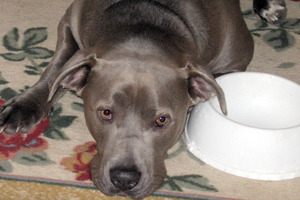The U.S. Food and Drug Administration’s Federal Food, Drug, and Cosmetic Act (FFDCA) strives to keep pets safe. The act requires truthful pet food labels, pet food production in sanitary conditions, the creation of consumable pet foods and the pet products should not contain any harmful substances.
But not all pet food and pet treat manufacturers adhere to these guidelines, leaving pets at risk for food-borne Salmonella poisoning.
Some pet food suppliers and processors outside the United States do not have any regulations regarding pet foods. Read pet food labels for the country of origin to determine any food handling guidelines before choosing to feed it to your dog.
About Salmonella
Salmonella, a bacteria that affects humans and animals (including birds) can spread to pets through consumption of contaminated dog food.
The United States Department of Agriculture’s Food Safety and Inspection Service documents over 1.4 million cases of Salmonella infections in humans each year. In addition to food sources, humans can contract the illness from infected pet foods or infected animal and human feces.
How Salmonella Affects Dogs
A dog infected by one of the more than 2,000 types of Salmonella bacteria will exhibit visible signs of illness. Common symptoms of Salmonella infection include fever, lethargy, diarrhea, vomiting and mucus in the stools, according to PetMD. The pet may also experience weight loss, dehydration, swollen lymphnodes and an increased heart rate.
Puppies with underdeveloped immune systems or immature gastrointestinal tracts experience a higher risk of elevated side effects from Salmonella infection. Older dogs, pets receiving antibiotic therapy and dogs with weakened immune systems are also at a higher risk of complications from Salmonella infections.
Diagnosing and Treating Salmonella Infections
When a veterinarian suspects Salmonella poisoning he may order urine, fecal and blood tests to confirm the diagnosis. If the dog exhibits signs of dehydration the veterinarian may offer a course of intervenous electrolyte fluids. Blood or plasma transfusions also rid the pet of infection.
Since an infected dog’s feces contains Salmonella, consider quarantining the pet to avoid passing the infection to humans or other pets that frequent the yard where the pet defecates.
Follow Up Safety
The Centers for Disease Control and Prevention recommends washing with warm soapy water after handling animal feces or pet foods. Cleaning pet litter pans, feces left during walks and build up of stools in the yard helps reduce the risk of Salmonella infections.
For a current listing of pet foods and treats recalled by the U.S. Food and Drug Administration please visit http://www.accessdata.fda.gov/scripts/newpetfoodrecalls/ .
Sources and Suggested Further Reading:
PetMD, “Salmonella Infection in Dogs”, PetMD
U.S. Food and Drug Administration, “Pet Food”, U.S. Department of Health and Human Services
Charles Davis, MD, PhD, “Salmonella”, MedicineNet
University of Wisconsin-Madison School of Veterinary Medicine, “Selected Zoonotic Agents of Gastroenteritis That Can Be Acquired From Dogs and Cats”, University of Wisconsin-Madison
Food Safety and Inspection Service, “Salmonella Questions and Answers”, United States Department of Agriculture
Centers for Disease Control and Prevention, “Questions and Answers Related to the Salmonella Typhimurium Outbreak and Pets”, Department of Health and Human Services
###
Reference:
- Why Dogs Eat Dirt: www.associatedcontent.com/article/2918286/why_dogs_eat_dirt.html?cat=53
- Understanding Natural, Holistic and Organic Pet Foods: www.associatedcontent.com/article/1342020/understanding_natural_holistic_and.html?cat
- What is Natural Cat Litter?: www.associatedcontent.com/article/1342140/what_is_natural_cat_litter_a_petco.html?cat
